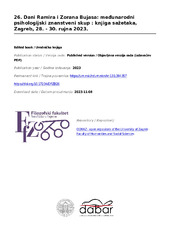Приказ основних података о документу
Differentiation of Self (DoS) of Emerging Adults in Serbia: Predictive Relationships Between DoS Subscales and Certain Aspects of Well-Being
| dc.creator | Grujić, Kristina | |
| dc.creator | Vuletić, Teodora | |
| dc.creator | Nikolić, Marija | |
| dc.date.accessioned | 2023-11-09T07:23:52Z | |
| dc.date.available | 2023-11-09T07:23:52Z | |
| dc.date.issued | 2023 | |
| dc.identifier.issn | 1849-6946 | |
| dc.identifier.uri | http://reff.f.bg.ac.rs/handle/123456789/5165 | |
| dc.description.abstract | This research was part of a broader study that investigated differentiation of self (DoS), a concept introduced by M. Bowen. Previous studies suggested that better DoS predicts higher levels of well being (WB). This work aimed to determine whether four subscales of Differentiation of Self Inventory, Emotional Reactivity (ER, 11 items), “I” Position (IP, 11 items), Emotional Cutoff (EC, 12 items), and Fusion with Others (FO, 12 items), represent significant predictors of different aspects of WB, measured through the Flourishing Scale (FS; Likert, 1-7), an 8-item summary (feeling of life purpose, social life satisfaction, engagement in everyday life, contributing to others’ well-being, self-esteem, self and life satisfaction, optimism, perceived respect of others). The sample included 364 university students, aged 18-30 (M = 21.44, SD = 2.36, 81.3% female). Multiple linear regression analysis was used. Following aspects of well-being were significantly predicted (p < .00): feeling of life purpose (R2 = .28) by EC (β = .38), IP (β = .28) & FO (β = -.16); social life satisfaction (R2 = .17) by EC (β = .33) & FO (β = -.28); engagement in everyday life (R2 = .20) by EC (β = .29), FO (β = -.20) & IP (β = .25); contributing to others’ well-being (R2 = .19) by EC (β = .30), FO (β = -.16) & IP (β = .28, p = .00); self-esteem (R2 = .18) by EC (β = .24) & IP (β = .29); self and life satisfaction (R2 = .27) EC (β = .38), IP (β = .29) & FO (β = -.23); optimism (R2 = .27) by EC (β = .28), IP (β = .32), ER (β = .19) & FO (β = -.17); perceived respect (R2 = .20) by EC (β = .28), IP (β = .20), ER (β = .19) & FO (β = -.17). As in previous studies, EC and IP proved to be the most stable predictors in each regression model. Conversely, ER was not significant in models 1-6, possibly due to the distinctions of participants’ developmental stage. Reasons for only negative beta coefficients regarding FO could be explained by the impact of cultural variables such as collectivism. This research provides the first evidence for unique predictive relations between the elements of self-differentiation and various aspects of well-being among emerging adults in Serbia. | sr |
| dc.language.iso | en | sr |
| dc.publisher | Department of Psychology, Faculty of Humanities and Social Sciences, University of Zagreb | sr |
| dc.relation | info:eu-repo/grantAgreement/MESTD/inst-2020/200163/RS// | sr |
| dc.rights | openAccess | sr |
| dc.rights.uri | https://creativecommons.org/licenses/by/4.0/ | |
| dc.source | Proceedings from 26th Ramiro and Zoran Bujas Days | sr |
| dc.subject | differentiation of self | sr |
| dc.subject | well-being | sr |
| dc.subject | emerging adults | sr |
| dc.subject | flourishing | sr |
| dc.subject | predictors | sr |
| dc.title | Differentiation of Self (DoS) of Emerging Adults in Serbia: Predictive Relationships Between DoS Subscales and Certain Aspects of Well-Being | sr |
| dc.type | conferenceObject | sr |
| dc.rights.license | BY | sr |
| dc.citation.rank | M34 | |
| dc.citation.spage | 77 | |
| dc.identifier.fulltext | http://reff.f.bg.ac.rs/bitstream/id/12810/drzb26_knjiga-sazetaka_2023-11-06.pdf | |
| dc.identifier.rcub | https://hdl.handle.net/21.15107/rcub_reff_5165 | |
| dc.type.version | publishedVersion | sr |

